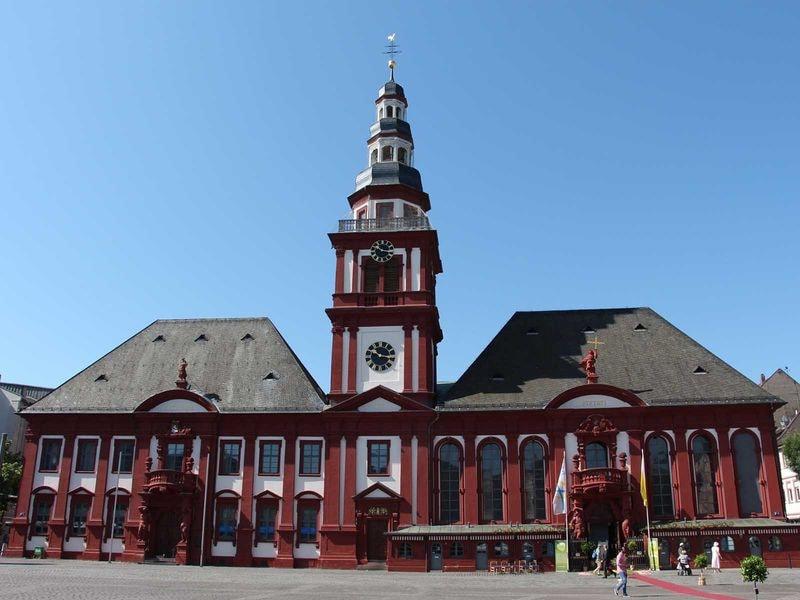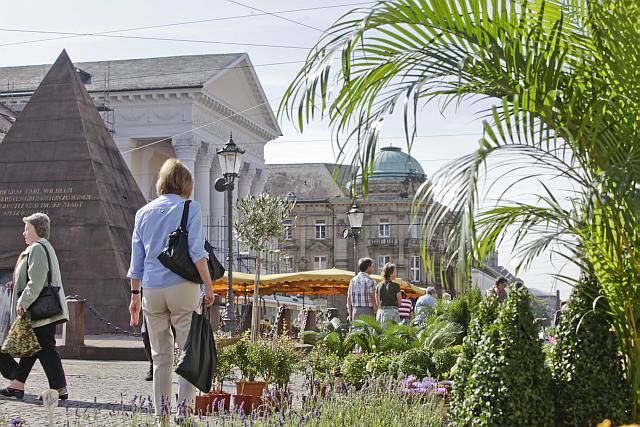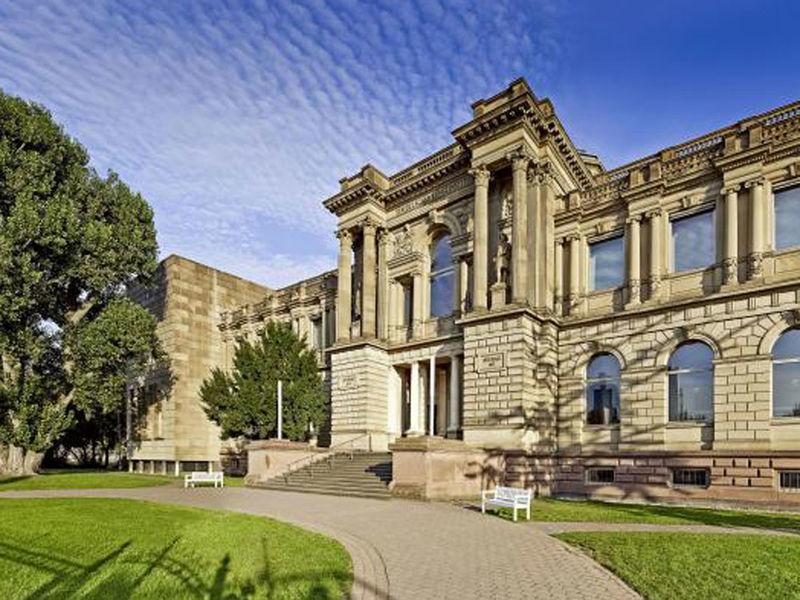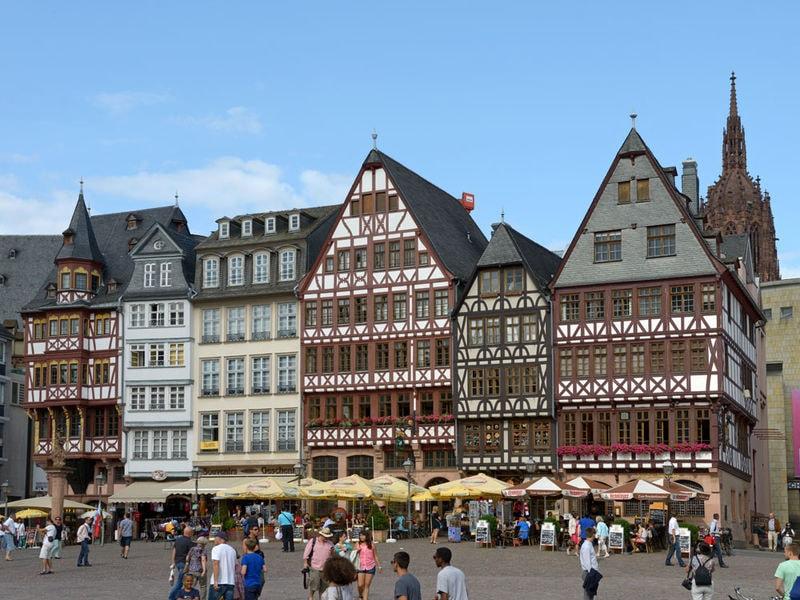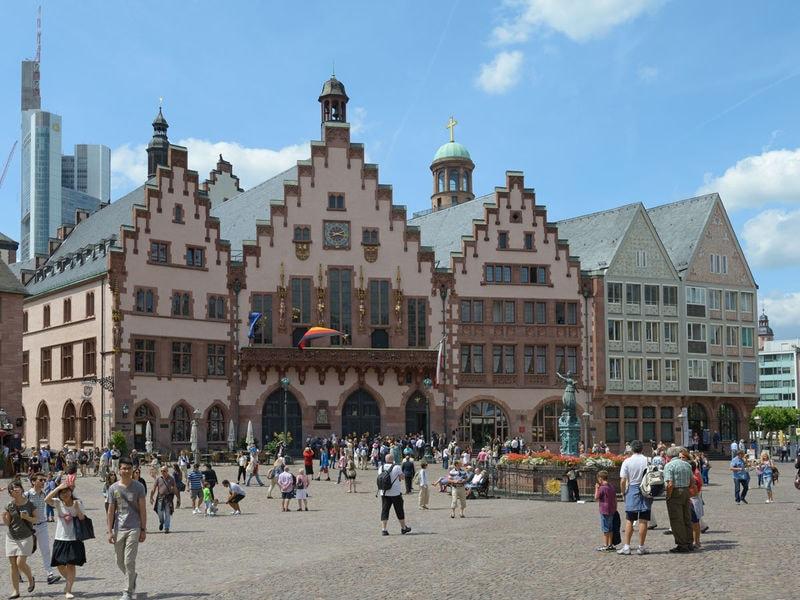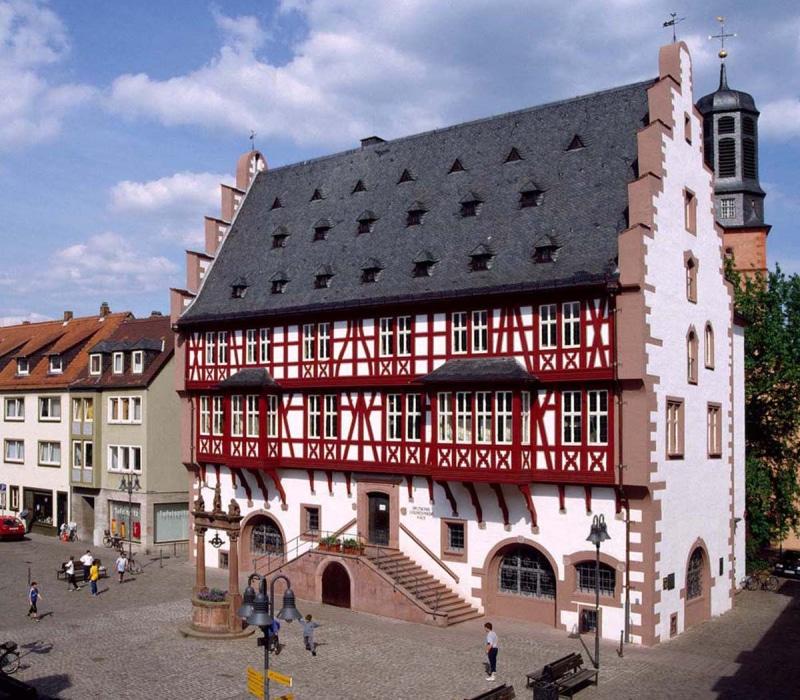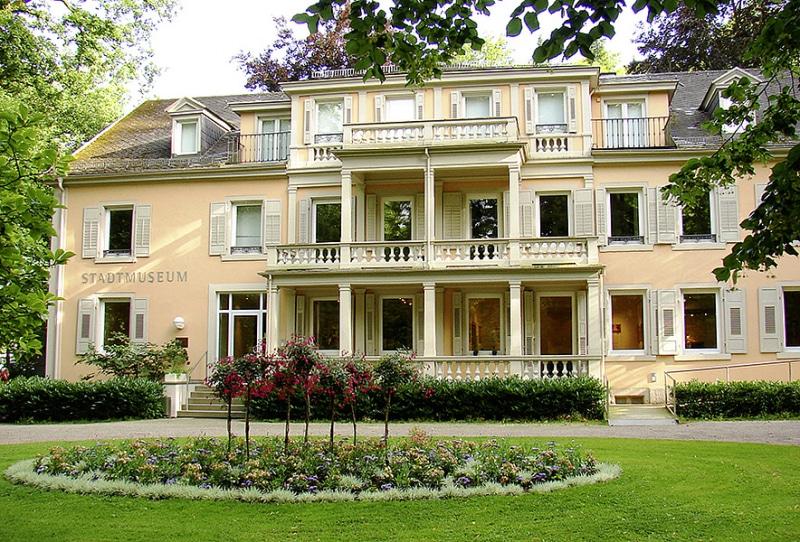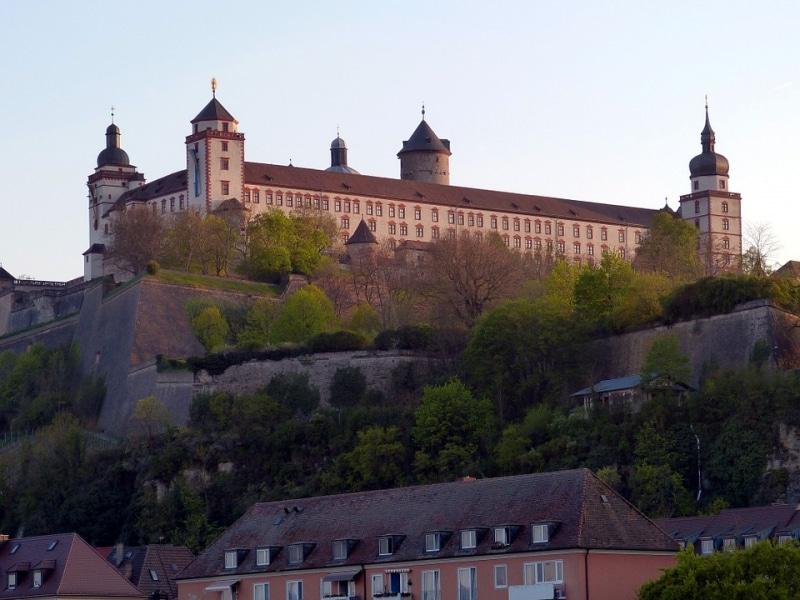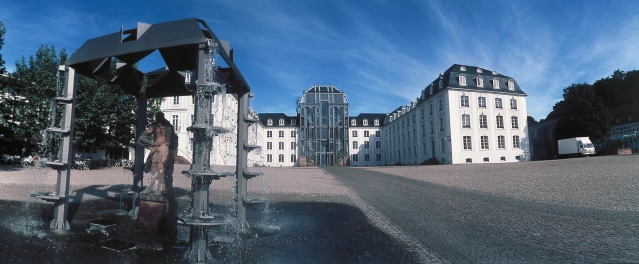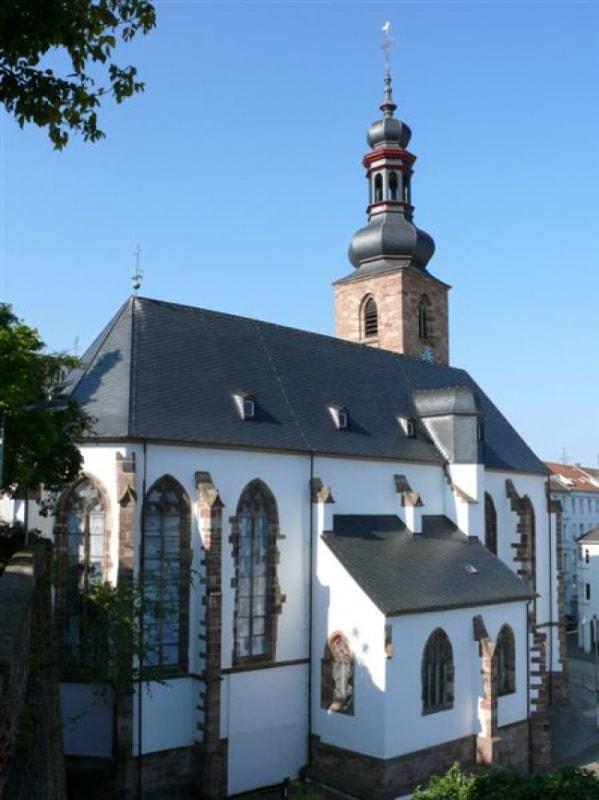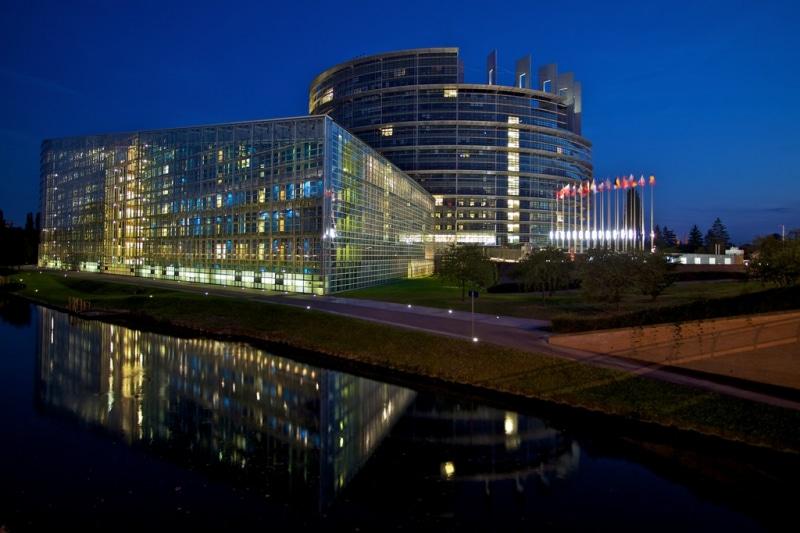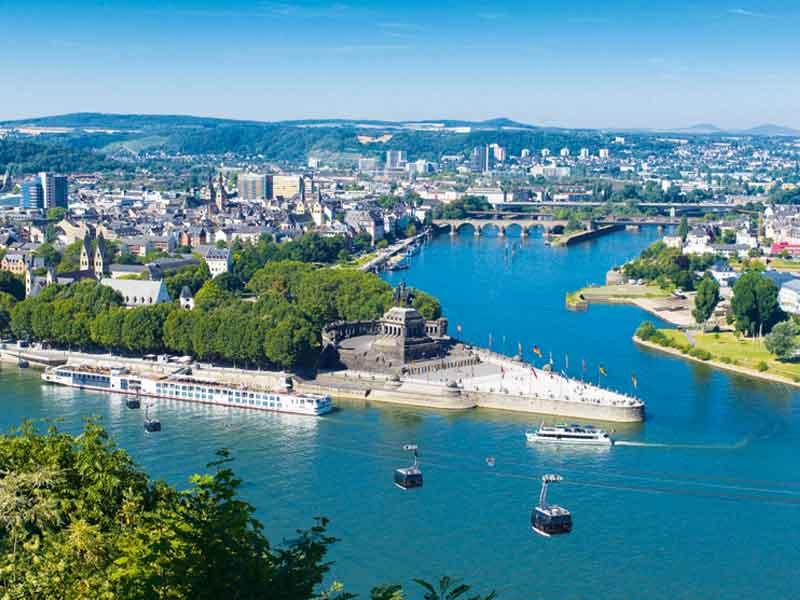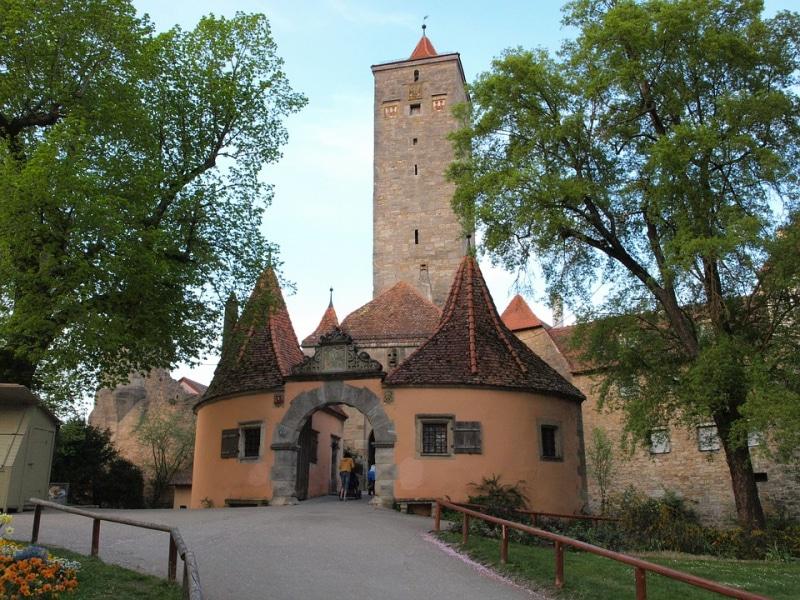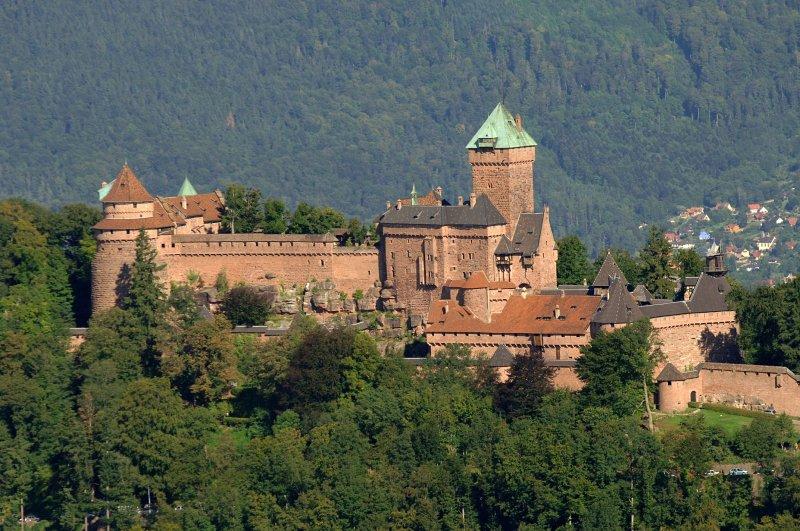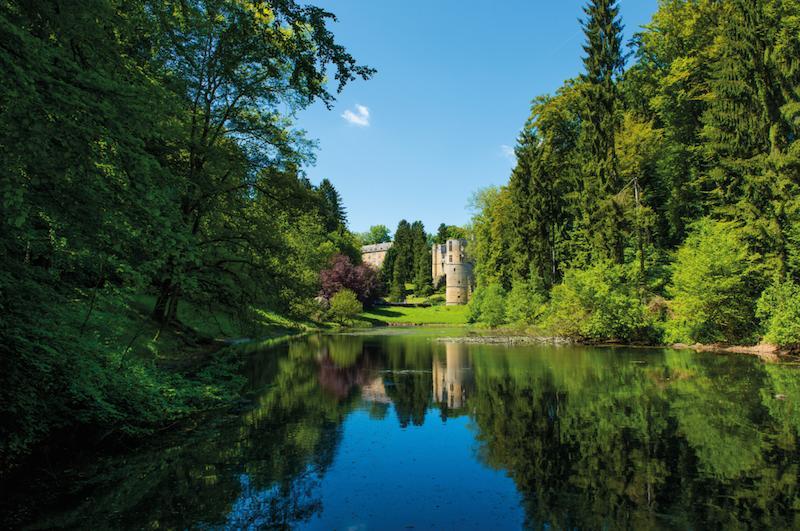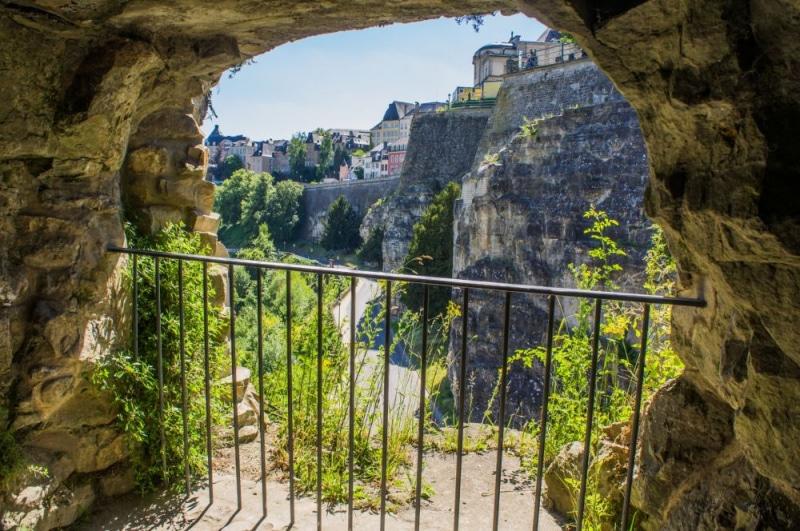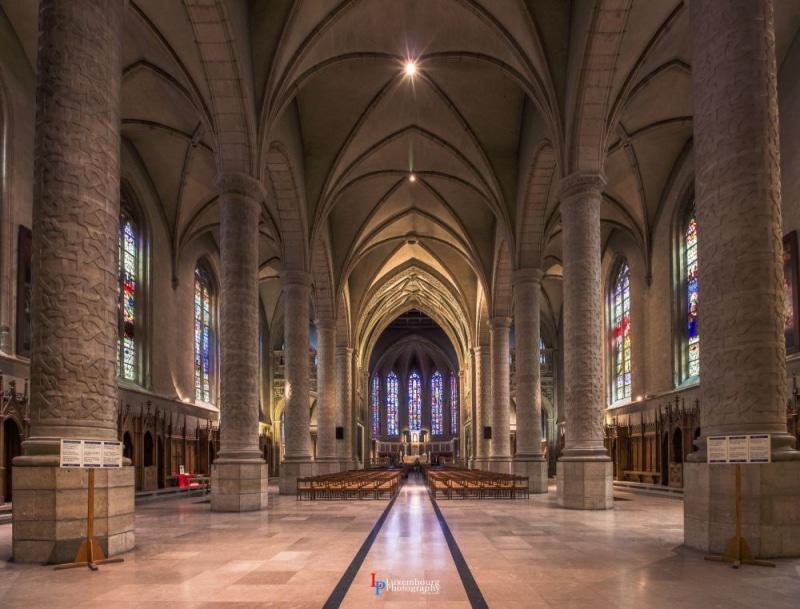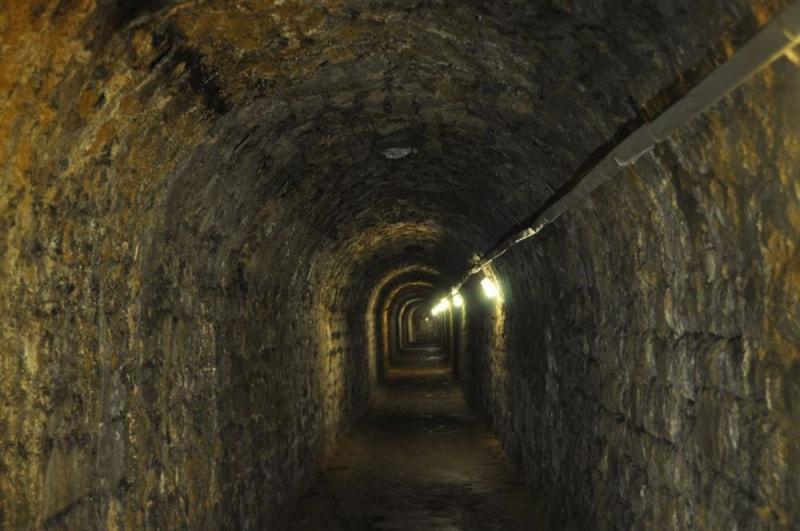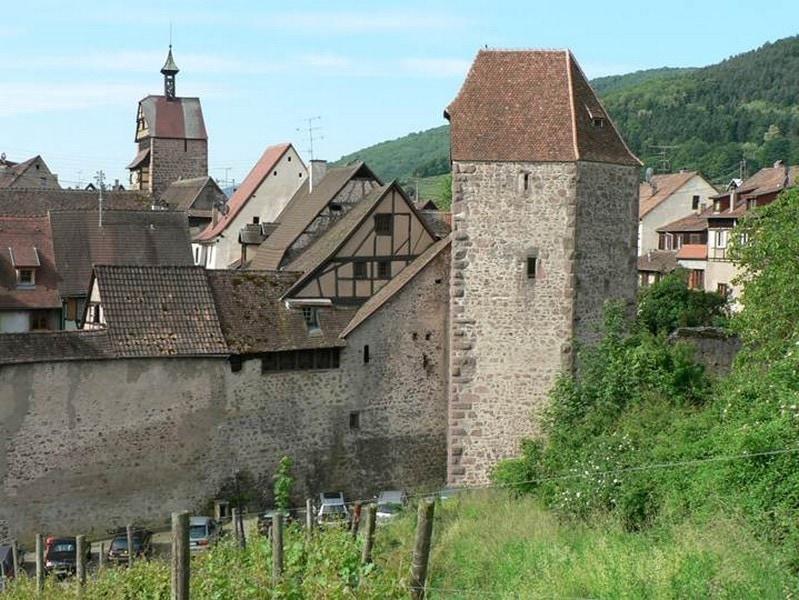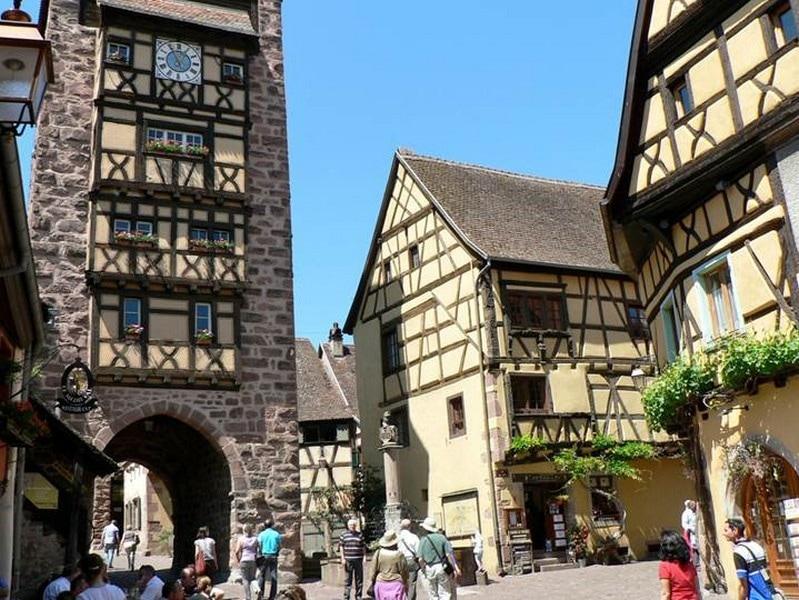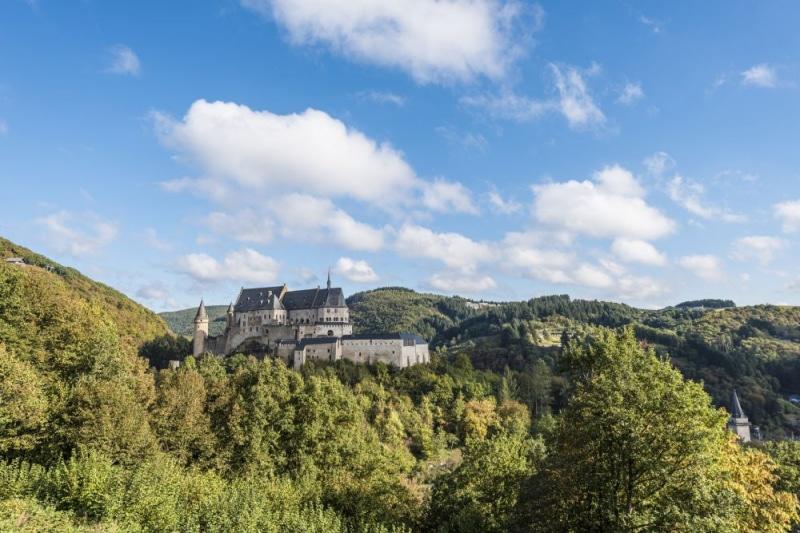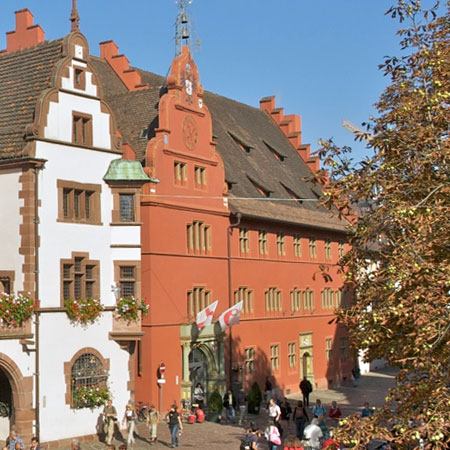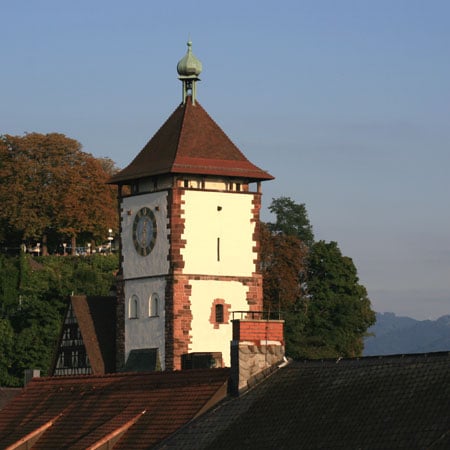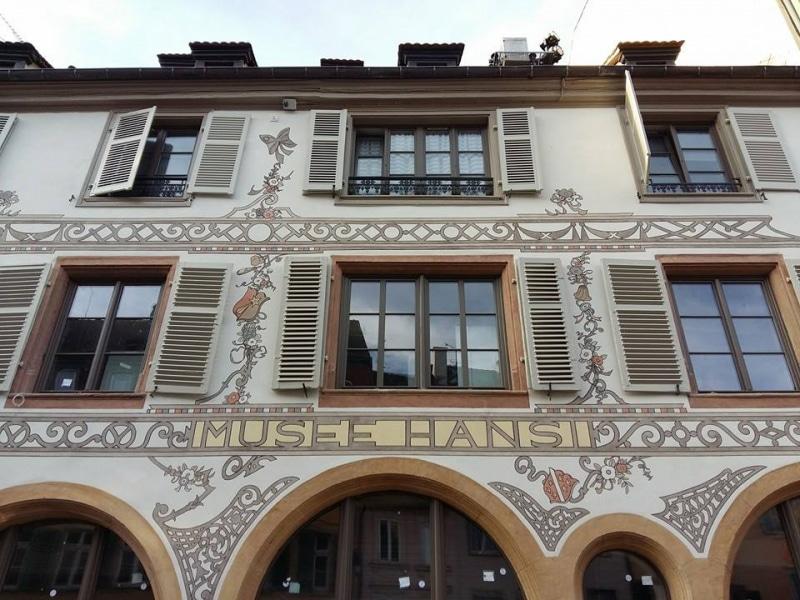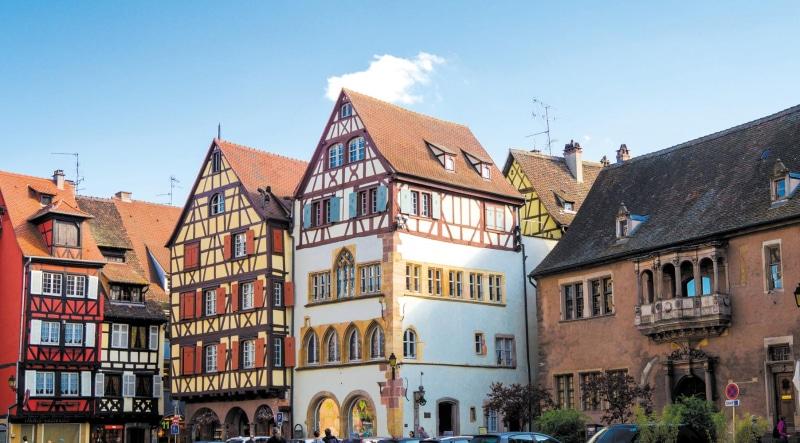HistoricalSites, Mannheim
Removed from Unnamed collection
Baroque palace Mannheim
The imposing baroque palace with its impressive size is not without reason the largest Baroque palace in Germany. Stroll across the wide Ehrenhof, be impressed in the former State Rooms and the Castle Church or enjoy the student bustle of the University of Mannheim, which is located in the castle. https://www.visit-mannheim.de/Media/attraktionen/barockschloss-mannheim
Map
Removed from Unnamed collection
Old Town Hall and St. Sebastian Church
The baroque backdrop for the market held here three times a week is formed by the ensemble of the old town hall and the parish church of St. Sebastian - which is incidentally Mannheim's oldest building. If you happen to lose track of time in the hustle and bustle of the market, two clocks and a bell tower are on hand to bring you back to the here and now. What's more, a glockenspiel sounds from the tower three times a day, charming more people than merely the wedding couple exchanging vows inside the walls.
You can immerse yourself in Mannheim's internationality directly behind the marketplace. The predominantly Turkish-influenced district with its small shops and delicacies like baklava and pide can easily turn your thoughts to your next holiday. The huge selection of bridal and evening wear on offer here draws customers from over 150 kilometers away. https://www.visit-mannheim.de/en/Media/attractions/old-town-hall-and-st.-sebastian-church
Map
Explore more places related to this search:
Removed from Unnamed collection
Jewish Museum Worms
There was a Jewish Community in Worms for an uninterrupted period lasting more than 900 years. Many architectural reminders have survived and bear witness today to the former importance of Jewish Worms. https://www.worms.de/en/tourismus/museen/juedisches_museum/
Map
Removed from Unnamed collection
Karlsruhe Palace
Karlsruhe's palace was built between 1715 and 1718. For almost 200 years it served as the residence and seat of government of the margraves, the electoral princes and grand dukes of Baden. https://www.karlsruhe-tourismus.de/en/Media/Attraktionen/Karlsruhe-Palace
Map
Removed from Unnamed collection
Market Square (Marktplatz)
The market square (Marktplatz) is in all probability the best-known square in Karlsruhe. Situated on it is the city's hallmark, the pyramid, built in 1823 as well as the municipal protestant church, the town hall, and the market fountain.
Images
Information https://www.karlsruhe-tourismus.de/en/overview-map/Sights/Highlights/Market-Square-Marktplatz-and-the-Pyramid
Map
Removed from Unnamed collection
Kurhaus
The Wiesbaden Kurhaus is an event venue which has a rich history and also provides the modern equipment capable of transforming any convention, conference and social event into a special experience. https://www.wiesbaden.de/en/tourism/conventions/kurhaus/index.php#
Map
Removed from Unnamed collection
Staedel Museum
Established as a civic foundation in 1815 by the banker and businessman Johann Friedrich Städel, the Städel Museum ranks as Germany’s oldest museum foundation. https://www.frankfurt-tourismus.de/en/Discover-Experience/Best-of-Frankfurt2/Staedel-Museum
Removed from Unnamed collection
Roemerberg (Ostzeile)
It now represents a classic example of the traditional half-timbered architectural style of times gone by. Every single house bears its own name. In the 17th century, the corner house, named "Grosser Engel", became the home of Frankfurt's first bank. https://www.frankfurt-tourismus.de/en/Discover-Experience/Best-of-Frankfurt2/Roemerberg-Ostzeile
Removed from Unnamed collection
Roemer (City Hall)
This former Patrician Villa, featuring a three-gabled Roof, has served as Frankfurt's city hall since 1405. It continues to be the seat of the city's Lord Mayor to this day.
The city's first town hall was soon too small to accommodate the needs of this flourishing city. It was torn down in 1415 prior to commencement of construction on the cathedral tower. The city council was initially accorded the right to build a new town hall in 1329. Finally, in 1405, the council decided to buy two existing houses instead. These two houses, named "Römer" and "Goldener Schwan", have served as the home of Frankfurt's town hall ever since. Large halls were constructed on the ground level and made available for lease during trade fairs. The Kaisersaal, or "Emperor's Hall", was built around 1612. The town hall complex formerly comprised 13 buildings. There are equally many hypotheses as regards to the origin of the name. One of them states that the merchant who lived there until the building was purchased by the city transacted the majority of his business with Italy, and in particular, Rome. https://www.frankfurt-tourismus.de/en/Discover-Experience/Best-of-Frankfurt2/Roemer-City-Hall
Removed from Unnamed collection
Emperors Cathedral
The present-day Frankfurt Cathedral was originally a Carolingian chapel. Although called a cathedral since the 18th century, it never was an episcopal church in the true sense. Consecrated in the name of St Bartholomew in 1239, this cathedral was officially chosen to serve as the electoral site for kings of the Holy Roman Empire in 1356. Ten imperial coronations took place here between 1562 and 1792. https://www.frankfurt.de/sixcms/detail.php?id=317578&_ffmpar[_id_inhalt]=5021018
Removed from Unnamed collection
Johannisburg Palace
This palace, made of red sandstone, is one of the most significant and beautiful Renaissance buildings in Germany. Its unique features include the chapel (complete with Renaissance altar, pulpit and portal sculptures by Hans Juncker), the royal living quarters, the world's largest collection of architectural models made from cork, the state gallery with paintings by Lucas Cranach the Elder and the Palace Museum of Aschaffenburg that houses works by Ernst Ludwig Kirchner and Christian Schad. https://www.info-aschaffenburg.de/en/tourism/tourist-attractions.html
Map
Removed from Unnamed collection
Goldsmiths House
Located in the heart of Hanau's historic district, the German Goldsmiths' House was built as the city hall on the Altstädter Markt in 1537-1538 in the style of the late Renaissance Period. http://www.goldschmiedehaus.com/en/goldschmiedehaus/en-historie
Map
Removed from Unnamed collection
The Baden-Baden Musuem
Find out about Baden-Baden under the Romans, its history as a spa town and health resort, the heady days of the nineteenth century when the town soared to being a world renowned spa, and many other fascinating facts and features, right up to the present day. https://www.baden-baden.de/en/tourist-information/places-of-interest/artistic-and-cultural-entertainment/the-baden-baden-museum/
Map
Removed from Unnamed collection
Festung Marienberg
The Fortress Marienberg is the most dominating feature of the city; it towers above it all. Take a tour and learn about its history.Fortress Marienberg is visible from seemingly everywhere in Würzburg. http://www.wuerzburg.de/en/visitors/must-sees/22689.Festung-Marienberg-Fortress-Marienberg.html
Map
Removed from Unnamed collection
Saarbruecken Castle
In the 17th century the castle was rebuilt in the style of the Renaissance, but later destroyed and now only the cellars of this construction remain. In the 18th century Prince Wilhelm Heinrich had his architect Stengel build a new Baroque residence on the same site. Since then the castle has suffered various bouts of destruction and was partially burnt down and reconstructed before being thoroughly and magnificently renovated in 1989. http://www.saarbruecken.de/en/tourism/saarbruecken/sights/saarbruecken_castle
Map
Removed from Unnamed collection
Schlosskirche (Castle Church)
The steeple of the late Gothic Schlosskirche (Castle Church) dating from the 15th century was given a Baroque crest by Stengel in 1743. http://www.saarbruecken.de/en/tourism/saarbruecken/sights/schlosskirche_castle_church
Map
Removed from Unnamed collection
The European Parliament
Founded in 1979, the European Parliament has been home to 785 Euro MPs representing the 27 countries of the European Union since 1 January 2008. Here, they vote on legislation concerning the environment, labour, equality etc. The sittings are held 4 days a month in Strasbourg. The building of the European Parliament called "Louise-Weiss" after the oldest member who gave the opening speech at the 1st session of the Parliament. https://www.tourisme-alsace.com/en/223007625-The-European-Parliament.html
Map
Removed from Unnamed collection
The Residence Palace
The Residence Palace – The “Castle above all Castles”! The Residence Palace is one of Europe’s most renowned Baroque castles and has been registered as a UNESCO World Cultural Heritage Site in 1981. http://www.wuerzburg.de/en/visitors/must-sees/22688.UNESCO-World-Cultural-Heritage-Site-Residence-Palace.html
Map
Removed from Unnamed collection
The Deutsches Eck
The establishment of the Teutonic Order at the confluence of the Rhine and Moselle in 1216 gave this historic site its name, the “Deutsches Eck” (“German Corner”). Koblenz also owes its name to the meeting point of the Rhine and the Moselle - from “Castellum apud Confluentes”, Latin for “fort at the confluence”, which over time became the current name of Koblenz. http://www.koblenz-tourism.com/culture/koblenz-attractions/deutsches-eck.html
Map
Removed from Unnamed collection
Rothenburgs Castle Garden
Where is the castle (or “Burg”) in Rothenburg ob der Tauber? You often hear this question and just as often get disappointed faces in return. Because there hasn’t been a castle in Rothenburg ob der Tauber for a long time – the former Stauferburg was destroyed. However, the disappointment soon vanishes, because in the castle’s location is Rothenburg’s green oasis, the Castle Garden. What’s so special about the Castle Garden? And where in the Castle Garden do you get the best views? We explain why it’s worthwhile to spend some time in Rothenburg’s Castle Garden. https://www.rothenburg-tourismus.de/en/discover/the-highlights-of-rothenburg-ob-der-tauber-top10-sights/a-park-for-taking-a-break-rothenburgs-castle-garden/
Removed from Unnamed collection
Porta Nigra
For the newly arrived guest, the Porta Nigra is the best place to begin a tour of Trier. The gate dates back to a time (about A.D. 180) when the Romans often erected public buildings of huge stone blocks (here, the biggest weigh up to six metric tons). http://www.trier-info.de/english/porta-nigra-info
Map
Removed from Unnamed collection
Haut-Koenigsbourg Castle
The characteristic silhouette of the Haut-Koenigsbourg castle marks the Alsatian landscape for nearly 900 years. Visible from afar, the imposing fortress nestled at an altitude of 757 meters in the heart of the Vosges forest, dominates the wine trail that winds at its feet and offers a grandiose panorama of the plain of Alsace, the valleys and the balloons of the Vosges, the Black Forest, and on a clear day, the Alps . http://www.ribeauville-riquewihr.com/LEI/Haut-Koenigsbourg-Castle.htm?HTMLPage=/en/visit/castles.htm&action=&page=1&commune=&categorie=1900045s1900200&genre=1900009&nom_recherche=&ID=269000048&GENRE=1900009&CATEGORIE=1900045&langue=2&sessionalea=0,9771997
Map
Removed from Unnamed collection
Beaufort Castles
The old castle, protected by a moat, was built in four periods. The oldest part of the castle dates from the early 11th century. It was a small square-shaped fortress on a massive rock, surrounded by a wide ditch and a second wall facing the valley. Around the first half of the 12th century, a flanking tower was added and the access gate was moved and enlarged. http://www.visitluxembourg.com/en/place/castle/beaufort-castle
Map
Removed from Unnamed collection
Former Castle of the Counts of Luxembourg
The name Luxembourg was first mentioned in 963 when count Siegfried exchanged lands for a small fortified castle by the name of Lucilinburhuc. Throughout the Middle Ages, the House of Luxembourg considerably extended its territory and power. Between 963 and 1443 Luxembourg was independent, at first as a County, then since 1354 as a Duchy. In the 14th Century and the first half of the 15th Century, four Holy Roman Emperors and four Kings of Bohemia came out of the House of Luxembourg.
Thanks to its strategic position in Europe and its formidable fortress - referred to as “Gibraltar of the North” - Luxembourg was much coveted. Thus -between 1443 and 1815- the castle of Siegfried had to endure a succession of Burgundian, Spanish, French and Austrian rulers who each shaped the fortress and the surrounding countryside.
After the defeat of Napoleon, the Powers of the time gathered at the Congress of Vienna in 1815 to reorganise Europe. Due to the importance of the fortress they decided to create a new country around the fortified castle on the Bock: the Grand Duchy of Luxembourg. https://www.visitluxembourg.com/en/place/castle/the-former-castle-of-the-counts-of-luxembourg
Map
Removed from Unnamed collection
Bock Casemates
In 963, Count Siegfried built a fortified castle on the Bock promontory, which was soon to become the cradle of the city. In the course of the centuries, on the western side, mighty ring walls were added, which, however, did not foil the Burgundians in their attempt to conquer the city in 1443. The best builder-engineers of the new masters (the Burgundians, the Spaniards, the French, the Austrians and the German Confederation) eventually turned the city into one of the most powerful emplacements in the world, the "Gibraltar of the North". Its defences were bolstered by three fortified rings with 24 forts, 16 other strong defensive works and a unique 23 km long network of casemates: these could not only shelter thousands of soldiers and their horses, but also housed workshops, kitchens, bakeries, slaughter-houses etc. https://www.visitluxembourg.com/en/place/castle/bock-casemates-luxembourg
Map
Removed from Unnamed collection
Cathedral Notre-Dame
The cathedral "Notre-Dame" of Luxembourg was built between 1613 and 1621 by the Jesuits to serve as a church to their college (now the National Library). The north gate is characteristic of the semi-Renaissance, semi-Baroque style of the period. Since 1794, it has housed the statue of the Consoler of the Afflicted. A cathedral church in 1870, it was enlarged from 1935 to 1938. The choir screen in richly sculpted alabaster, columns decorated with arabesques, stained glass from the 19th and 20th centuries, neo-Gothic confessionals, modern sculptures in bas relief, bronze gates by Auguste Trémont, are all worthy of this splendid sanctuary. The crypt is the resting place of John the Blind, King of Bohemia and Count of Luxembourg, as well as deceased members of the Grand Ducal family; the two lions flanking the entrance are also the work of Auguste Trémont. https://www.visitluxembourg.com/en/place/misc/cathedrale-notre-dame
Map
Removed from Unnamed collection
Petrusse Casemates
Their origin goes back to 1644, when the Spaniards reinforced the medieval fortifications. Under the supervision of the Swiss fortress builder Isaac von Treybach, they built - among other defence works-the powerful Beck Bastion, named after Governor Baron Johann von Beck, a native of the city who had played a key role in the Wallenstein affair on the side of the Emperor. Initially this bastion was as high as the adjacent terraces on the right; it was raised to the present level of Constitution Square (the wall is 27 meters high) by Vauban in 1685. In 1673 the Spaniards erected the so-called "Ravelin du Pate" to strengthen the defence of the Beck Bastion; this triangular construction is one of the few well-kept fortifications. Marshall de Vauban conferred the present shape to all the Petrusse fortifications and built the "Small Staircase". From 1728-29 the Austrians added the "Bourbon Lock" and the "Large Staircase" and in 1746 the casemates of the "Petrusse Battery" (54 gun emplacements). One century passed and the fortress was enlarged and reinforced: the second ring was extended and the third started, so that Luxembourg became the "Gibraltar of the North". By and by, the Petrusse fortifications fell into oblivion and neglect, as their strategic momentum limited itself to the valley. After the dismantling, stipulated by the 1867 London Treaty, they confined themselves to walling up the loopholes and most entrances. Only in 1933 were the Petrusse casemates valorized again: on 26th July, the first visitors were able to visit them. https://www.visitluxembourg.com/en/place/castle/petrusse-casemates
Map
Removed from Unnamed collection
The thieves tower and the winemaker
This defensive tower (beginning of the 14th century) was one of the ancient prisons of Riquewihr, the seat of feudal justice in the era when the town belonged to the Dukes of Wurtemberg. The ‘Thieves’ Tower” interconnects with the ‘Winemaker’s House”, which dates from the 16th century http://www.ribeauville-riquewihr.com/en/visit/museums.htm
Map
Removed from Unnamed collection
Dolder Belfry
Listed as « Museum of France », the museum of the Dolder Tower allows you to discover the fortified rural medieval town of Riquewihr and its evolution from the 12th to the 17th century. http://www.ribeauville-riquewihr.com/LEI/Dolder-Belfry.htm?HTMLPage=/en/visit/museums.htm&action=&page=1&commune=&categorie=1900045s1900200&genre=1900009&nom_recherche=&ID=269000044&GENRE=1900009&CATEGORIE=1900045&langue=2&sessionalea=0,6847345
Map
Removed from Unnamed collection
Castle of Vianden
Vianden Castle was built between the 11th and 14th Century on the foundations of a Roman castle and a Carolingian refuge. This Castle-Palace bears the Hohenstaufen characteristics and is one of the largest and finest feudal residences of the Roman and Gothic eras in Europe.
Until the early 15th Century it was home to the powerful Counts of Vianden who could boast of their close connections to the German Imperial Court. The greatest of them, Count Henry I (1220 -1250) was even married to a member of the Capetian family, which ruled France at the time. In 1417, the castle and its lands were inherited by the younger line of the German House of Nassau, which -in 1530- also acquired the French principality of Orange. The castle's most remarkable rooms; the chapel as well as the small and the grand palaces were built in the late 12th and the first half of the 13th Century.
In 1890 the castle became the property of Grand Duke Adolphe of the elder line of Nassau and remained in the hands of the Grand Ducal family until 1977 when it was transferred into state ownership. It has been painstakingly restored to its former glory and today ranks among the most significant historical monuments of Europe. https://www.visitluxembourg.com/en/place/castle/vianden-castle
Map
Removed from Unnamed collection
Altes Rathaus (Old Town Hall)
The Old Town Hall is located next to the New Town Hall on the Rathausplatz. The two buildings are joined by a bridge and both house the offices of Freiburg's city government.
The history of the Old Town Hall dates back to the late 13th century, when the city of Freiburg erected an initial building on what was the Franziskanerplatz (now the Rathausplatz) as office space for the town clerks.
In the High Middle Ages, Freiburg was of one Baden’s flourishing cities, resulting, over time, in the need for a larger city government. The city was forced to purchase more buildings or build new ones, leading to the completion of the Old Town Hall in 1559.
Today, the ground floor of the Old Town Hall houses the Tourist Information Office. The historic entrance hall leads to an open area. A stroll across the excavated cobblestones from the Middle Ages brings you to our offices. https://visit.freiburg.de/en/attractions/altes-rathaus-old-town-hall
Map
Removed from Unnamed collection
Schwabentor (Swabian gate)
Due to the oldest crossing of the river Dreisam and the Oberlinden road junction, the Obertor or the Schwabentor gates were of particular importance which was also demonstrated with the weir system. http://www.freiburg.de/pb/,Len/225923.html
Map
Removed from Unnamed collection
The Hansi Village and its Museum
The Village of Hansi and his Museum is located in front of the famous "Maison des Têtes". Come in and discover the city of Colmar in the lifetime of the famous artist Jean-Jacques Waltz, so called "Hansi". Find out about the fascinating World of Hansi in our Museum on the first floor. Nowadays as a part of the alsatian cultural heritage, his original artworks will allow you to dive into the romantic and fascinating Alsace that he experienced. https://www.tourisme-colmar.com/en/visit/presentation/museums/F235014585_the-hansi-village-and-its-museum-colmar
Map
Removed from Unnamed collection
Adolph House
Built around 1350, this house is considered to be one of the oldest in Colmar. It owns its name to the Adolph family, who removed the gothic picture windows at the end of the 19th century. https://www.tourisme-colmar.com/en/visit/presentation/architectural-heritage/F235008788_adolph-house-colmar
Map
Removed from Unnamed collection
Altenburg Castle
Altenburg castle is perched on top of Bamberg's highest hill and is one of Bamberg's major landmarks. https://en.bamberg.info/poi/altenburg_castle-4647/
Map



